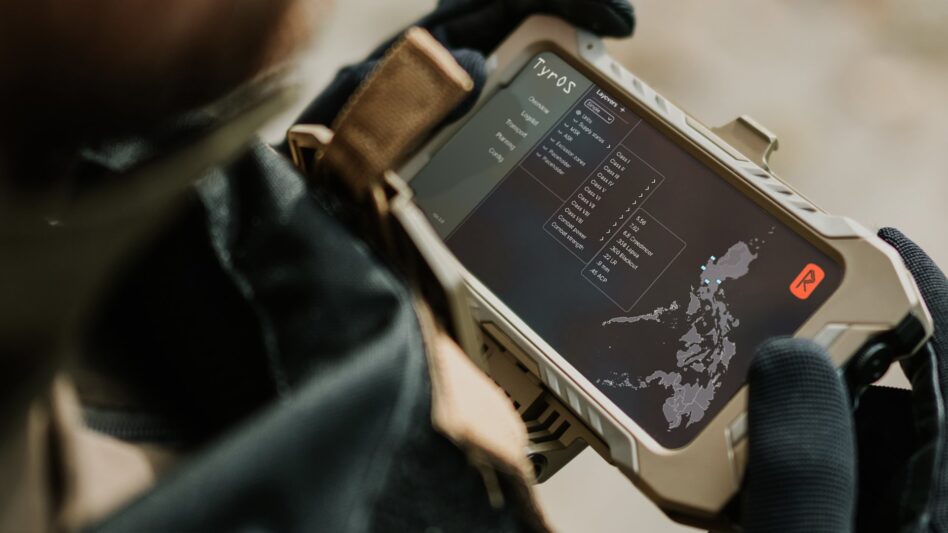Big day for all the sustainment nerds out there. Yesterday, military logistics startup Rune Technologies announced they’ve raised a $24M Series A led by Human Capital, with participation from Pax VC and Washington Harbour Partners. Existing investors Andreessen Horowitz, Point72 Ventures, XYZ Venture Capital, and Forward Deployed VC also returned to the table.
The raise comes just six months after the company announced a $6.2M seed round led by Andreessen Horowitz.
Rune CEO David Tuttle and CTO Peter Goldsborough told Tectonic that they plan to use the cash to (carefully) expand their DC area team, further develop their TyrOS military logistics software, and test as much as possible with the military. They’re also looking at new military customers and applications for the software.
“We’ve seen significant demand from across the services for a product that can replace the whiteboards and spreadsheets that are currently used to track logistics operationally,” Rune CEO David Tuttle said in a statement, “This investment will allow us to accelerate our deployment of TyrOS to sustainers across the joint force.”
On the frontline: Rune was founded last year in Arlington by Tuttle (ex-Anduril and JSOC) and Goldsborough (ex-Anduril and Facebook). The company set out to solve a pretty daunting problem: using AI and modern software to revolutionize logistics and sustainment.
In Tuttle and Goldsborough’s words, Rune’s software is designed for the “unsexy” parts of the military. They wanted to help logisticians—the people who move gear, fuel, food, and parts around—get critical kit to where it needed to be faster and more efficiently. After all, none of the sexy drones we all know and love work if there isn’t fuel to power them.
Enter: TyrOS. The operating system:
- Uses masses of data and AI to track and allocate resources more quickly and accurately than Excel, whiteboards, or pen and paper.
- Can predict future needs and help pre-emptively allocate supplies more efficiently.
- Designed to run on low-connectivity edge devices down “to the crappiest Dell laptop,” per Tuttle.
- Set up to keep the human in the loop. TyrOS works alongside logisticians, rather than replacing them.
- Designed to work across domains. That means it can provide air, land, and sea logistics support.
It’s also got a plan-generating function (think ChatGPT for sustainment). So if, as an operator, you’re in the middle of nowhere and you’ve only got two hours to get a whole bunch of ammo to a part of the frontline that’s popping off, TyrOS can spit out an AI-generated plan for how to do just that. You—the human—can then add tweaks and updates, and the system will integrate them.
Earlier this spring, Rune was selected as part of the Palantir Startup Fellowship and was integrated into Palantir’s Defense OSDK (Ontology Software Development Kit). Friends in high places, are we right?
Customer service: For Goldsborough and Tuttle, it’s critical to build something that logisticians and the broader military actually need. They spent months making sure TyrOS was viable before they even approached the military. And now, they test as much as possible on military exercises to make sure it helps get things to where they need to be faster. So far, they’ve been deployed with the US Army and Marine Corps.
“It’s actually by doing these exercises and being really close to our customers that we can iterate and become better,” Goldsborough said, “Not everything was perfect, not everything didn’t need a little touch up…but that’s actually why we go there, so we can learn and improve and can get better.”
The good news is, the feedback from military users has been mostly positive. After their last demo, a military user told the Rune team, “[they] showed [her] in five minutes what it would have taken three weeks to get done.”
Future so bright: The plan from here is to keep on building. In terms of TyrOS, Tuttle described the expansion plan as two-fold. They’ll seek out new customers— including new services and unnamed NATO partners in Europe—while also expanding how the software can be used.
“When we think about sustainment as a whole ecosystem, there are other parts,” Tuttle told Tectonic, “There’s inventory…there’s distribution…there’s medical…there’s personnel…all of those areas need modernization and modern software.”
And as for the team:
- Rune has doubled in size since the beginning of the year to just under 20 employees
- They plan to double again by the end of the calendar year—but both Tuttle and Goldsborough underlined that they will be careful with hiring and don’t want to expand too quickly.
For Tuttle, getting logistics and sustainment right can’t happen quickly enough—especially if you’re thinking about a potential fight with China in 2027.
“If US involvement or NATO involvement happens in some kind of large-scale conflict against a peer or near-peer adversary, the scale and the pace that is going to be required of the logistics enterprise is going to rapidly overcome anything that we saw in the last 20 years of Middle East conflicts,” he said, “I think that’s that’s a very big change.”

